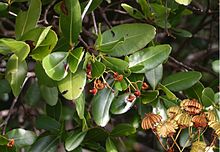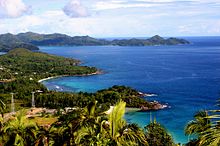- Medusagyne
-
Medusagyne 
Jellyfish tree with fruit. Conservation status Scientific classification Kingdom: Plantae (unranked): Angiosperms (unranked): Eudicots (unranked): Rosids Order: Malpighiales Family: Ochnaceae Genus: Medusagyne
BakerSpecies: M. oppositifolia Binomial name Medusagyne oppositifolia
BakerThe jellyfish tree (Medusagyne oppositifolia) is a critically endangered and unusual tree endemic to the island of Mahé, of the Seychelles. It is the sole member of the genus Medusagyne. The plant was thought to be extinct until a few individuals were discovered in the 1970s.[1]
They are small trees which can reach up to 10 metres tall and have a dense, rounded crown of foliage.[2] The bark is dark and has many distinctive, deep fissures.[2] The leaves are shiny and leathery in appearance with a slightly scalloped edge; they turn bright red with age. Leaves are up to 8 cm in length.[2] The small, white flowers are difficult to see amongst the dense foliage; both male and bisexual flowers are carried on the drooping inflorescence.[2] The gynoecium of the flower resembles the tentacles of a jellyfish, hence the common and generic names of the plant. This plant exhibits many adaptations to dry climate, strange on a moist archipelago. It can withstand drought, and its seeds disperse by the wind. This suggests it has Gondwanan origins.[3] The fruits are green and rounded; the outer coat becomes reddish-brown with maturity and then dries, exposing the seeds within, which are then distributed by the wind.[2]
The genus Medusagyne is included in the family Ochnaceae, e.g. in the Angiosperm Phylogeny Group classification, though it is sometimes included in the monogeneric family Medusagynaceae. The small tropical American family Quiinaceae is also included in this broad concept of Ochnaceae.[4]
Contents
Habitat
The tree inhabits exposed granite slopes, at present all locations are within 2 km of the sea.[2]
Threats
The jellyfish tree presents a conundrum in that the seeds seem unable to germinate in the wild; no young plants have been observed in the natural stands.[5] Successful cultivation in botanic gardens has occurred in very humid conditions, but high humidity is unlikely in the exposed habitat where these trees are found in the wild.[5] It has been suggested that jellyfish trees have been lost from the more appropriate habitat of moist forests through competition with other species and climate change.[5]
Conservation
Three of the existing populations of jellyfish tree on the island on Mahé (Bernica, Copolia and Mt. Jasmin) are protected within the Morne Seychellois National Park.[5] Although seedlings have been grown in a number of botanic gardens, many problems remain and a conservation priority must be further research into the reproductive biology of this intriguing species before any effective Action Plan for its future can be devised.[5]
References
This article incorporates text from the ARKive fact-file "Medusagyne" under the Creative Commons Attribution-ShareAlike 3.0 Unported License and the GFDL.
- ^ Nature Protection Trust of Seychelles (1998). Medusagyne oppositifolia. 2006. IUCN Red List of Threatened Species. IUCN 2006. www.iucnredlist.org. Retrieved on 09 May 2006.
- ^ a b c d e f Wise, R. (1998). A Fragile Eden. New Jersey: Princeton University Press.
- ^ Kingdon, Jonathan (1989). Island Africa: The Evolution of Africa's Rare Plants and Animals. Princeton, New Jersey: Princeton University Press. pp. 42–43. ISBN 0-691-08560-9.
- ^ Fay, M. F., Swensen, S. M. & Chase, M. W. (1997). Taxonomic affinities of Medusagyne oppositifolia. Kew Bulletin 52: 111-120.
- ^ a b c d e Gerlach, J. (1997). Seychelles Red Data Book. Seychelles: The Nature Protection Trust of the Seychelles.
External links
- Medusagyne oppositifolia media at ARKive
Categories:- IUCN Red List critically endangered species
- Ochnaceae
- Flora of Seychelles
- Endemic flora
- Monotypic plant genera
- Critically endangered plants
Wikimedia Foundation. 2010.


